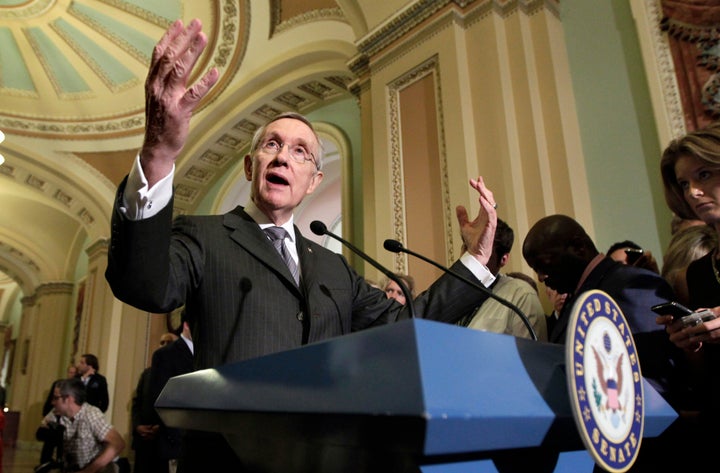
WASHINGTON -- Senate Majority Leader Harry Reid (D-Nev.) unveiled a new debt ceiling bill Friday night that strongly resembles a plan first suggested by his rival, Senate Minority Leader Mitch McConnell (R-Ky.).
The bill would cut the deficit by about $2.4 trillion over 10 years, and hike the debt ceiling by the same amount -- a key one-to-one match demanded by Republicans. It also includes a three-step process first proposed by McConnell that would let the president take responsibility of debt-limit increases.
But one item it did not contain -- and which a number of fence-sitting Republicans have hinted could ease them into a vote -- was some sort of "trigger."
A trigger is an enforcement mechanism written into the law in case Congress does not meet the deficit-reduction targets. It would guide a committee of 12 lawmakers (in effect a "super Congress"), helping it bring the budget into line. Republicans think a trigger would give that committee "teeth."
Choosing to include no trigger at all is a gamble on Reid's part. For the past few days, the main sticking point in discussions was over how lawmakers would give that committee the power to ensure its recommendations are enacted.
House Republicans added that level of enforcement by including only a short-term debt ceiling hike, saying that a second could be passed if and when the targets were being met (and a Constitutional amendment that balanced the budget was passed).
Democrats scampered around, looking for an alternative. In the end, they chose nothing at all, determining that there were simply no grounds on which they and the GOP could be satisfied -- at least for now.
"There is a closet full of triggers that people have suggested," Reid said, adding that he had lengthy conversations with Obama administration officials about them, but had no partner from the GOP side.
"We talked for an hour and a half on different triggers. I came to a conclusion we are negotiating with ourselves," Reid said.
This doesn't necessarily rule out the possibility triggers will find a way back into the legislation.
Rather, a trigger could be offered at the last minute as a means of winning a crucial GOP vote. But starting with nothing at all remains a gamble -- practically inviting Senate Republicans to shout that Democrats aren't serious about structural reforms to programs like Medicare, Medicaid or Social Security.
Sen. Chuck Schumer (D-N.Y.) said he felt like some Republicans were warming up to the Reid plan, but the acrimony was high between McConnell and Democratic leaders.
McConnell offered to hold a vote immediately on Reid's bill, but Reid refused, because it would need a 60-vote majority to pass, and Democrats do not yet have seven Republicans to join them.
Reid countered on the Senate floor that he'd be happy to have a simple, majority vote, like in the House, and McConnell scoffed. "Let me say this is almost an out-of-body experience," he said.
"It is obvious to the world, there is now another filibuster," Reid shot back.
Reid and Schumer both complained that McConnell has refused lately to negotiate, and Reid said that McConnell called him Friday evening to say he would not enter discussions with him -- only with President Obama. McConnell spokesman Don Stewart countered that McConnell simply wants the president involved to ensure Obama won't reject the measure at the last minute.
According to Stewart, although there's no meeting set with Reid and his boss, staff-level talks are ongoing.
In terms of the mechanics of the three-stage debt hike, it looks like another major compromise by the Democrats, and adopts a plan first proposed by McConnell. In the scheme, Congress would give the White House the authority to raise the debt limit, while retaining only the authority to disapprove by a supermajority vote.
A first increase would be a two-part jump that would hike the debt cap by $1.2 trillion, with the first $416 billion being free from any disapproval. That step would ensure a default is avoided if the measure is passed quickly.
The Senate and House could object to the rest of that money. The next $1.2 trillion would be authorized after the president certifies that the nation is within $150 billion of the new ceiling.
From the start of the debate, Democrats have moved from insisting there be no strings attached to raising the borrowing cap to now adding $2.4 trillion in cuts and an enforcement mechanism. They've also been adamant that the hike would have to last through the election season. This new three-step model edges away from that, but since it would be so hard to stop the White House from acting, they see it as almost as good.
One senior Democrat speculated McConnell was less interested in his own idea now because he had gotten hammered by the right for it.
Democrats were also quick to point out that, while McConnell mocked the idea of a simple majority vote on the debt ceiling Friday, he reportedly pushed for one back in April as a way to let Democrats take all the blame for raising the limit, which was less popular with the public at the time.
In order for the deal to happen now, it may take the White House to sign off. It also may take one more major compromise on the trigger.
Schumer told reporters, "The problem with a trigger is this: Republicans insist that it have no revenues and we insist it must have some revenues and some [saving]... So you will not get a trigger. No one has come up with a way to bridge that gap."
The country hits the debt limit at midnight on Aug. 2, and while some reports suggest revenues have been stronger than expected -- meaning there could be a few more days of wiggle room -- the country would begin the process of failing to pay its bills as the calendar turns to Aug. 3.